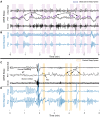A single-arm, open-label, multicenter, and comparative study of the ANNE sleep system vs polysomnography to diagnose obstructive sleep apnea
- PMID: 35934926
- PMCID: PMC9713912
- DOI: 10.5664/jcsm.10194
A single-arm, open-label, multicenter, and comparative study of the ANNE sleep system vs polysomnography to diagnose obstructive sleep apnea
Abstract
Study objectives: Evaluate per-patient diagnostic performance of a wireless dual-sensor system (ANNE sleep) compared with reference standard polysomnography (PSG) for the diagnosis of moderate and severe obstructive sleep apnea (OSA) with a minimum prespecified threshold of 80% for both sensitivity and specificity.
Methods: A multicenter clinical trial was conducted to evaluate ANNE sleep vs PSG to diagnose moderate and severe OSA in individuals 22 years or older. For each testing approach, apnea-hypopnea index (AHI) was manually scored and averaged by 3 registered sleep technologists blinded to the other system. Average variations > 15% were adjudicated by a sleep medicine physician.
Results: In a total of n = 225 participants (mean age 53 years, range 22-88 years), PSG diagnosed 30% (n = 68) of participants with moderate or severe OSA (AHI ≥ 15 events/h) compared to 29% (n = 65) diagnosed by ANNE sleep (P = .55). The sensitivity and specificity for ANNE sleep were 90% (95% confidence interval: 80-96%) and 98% (95% confidence interval: 94-99%), respectively. Strong correlation was shown in terms of final AHI (r = .93), with an average AHI bias of 0.5 (95% limits of agreement: -12.8 to 11.8). The majority of users noted comfort with using the ANNE sleep in the home setting. No adverse events were noted.
Conclusions: Using PSG as the gold standard, ANNE sleep demonstrated high sensitivity and specificity for the diagnosis of moderate or severe OSA.
Clinical trial registration: Registry: ClinicalTrials.gov; Name: Comparative Study of the ANNE™ One System to Diagnose Obstructive Sleep Apnea; URL: https://clinicaltrials.gov/ct2/show/NCT04643782; Identifier: NCT04643782.
Citation: Davies C, Lee JY, Walter J et al. A single-arm, open-label, multicenter, and comparative study of the ANNE sleep system vs polysomnography to diagnose obstructive sleep apnea. J Clin Sleep Med. 2022;18(12):2703-2712.
Keywords: diagnostic testing; flexible electronics; home sleep apnea testing; obstructive sleep apnea; patient preferences; polysomnography; wireless sensors.
© 2022 American Academy of Sleep Medicine.
Conflict of interest statement
All authors have seen and approved the manuscript. Work for this study was performed at Northwestern Memorial Hospital, Carle Foundation Hospital, Central DuPage Hospital, and Lake Forest Hospital. This study was funded by Elevance Health (S.B., L.K.). J.Y.L., H.C., and S.X. also recognize support from the National Institute of Health’s National Heart, Lung, and Blood Institute (1R43HL151549-01). J.Y.L., D.K., J.P., H.C., and D.S.R. are all employees of Sibel Health, the developer of the ANNE One system. The spouse of J.R.W. has stock ownership in Sibel Health and royalties as an inventor. J.Y.L., D.K., J.P., and S.X. report stock ownership in Sibel Health, and royalties as inventors related to the patents associated with the technology. The other authors report no conflicts of interest.
Figures




References
-
- Simpson L , Hillman DR , Cooper MN , et al. . High prevalence of undiagnosed obstructive sleep apnoea in the general population and methods for screening for representative controls . Sleep Breath. 2013. ; 17 ( 3 ): 967 – 973 . - PubMed
-
- Finkel KJ , Searleman AC , Tymkew H , et al. . Prevalence of undiagnosed obstructive sleep apnea among adult surgical patients in an academic medical center . Sleep Med. 2009. ; 10 ( 7 ): 753 – 758 . - PubMed
-
- Tarasiuk A , Reuveni H . The economic impact of obstructive sleep apnea . Curr Opin Pulm Med. 2013. ; 19 ( 6 ): 639 – 644 . - PubMed
Publication types
MeSH terms
Associated data
Grants and funding
LinkOut - more resources
Full Text Sources
Other Literature Sources
Medical

